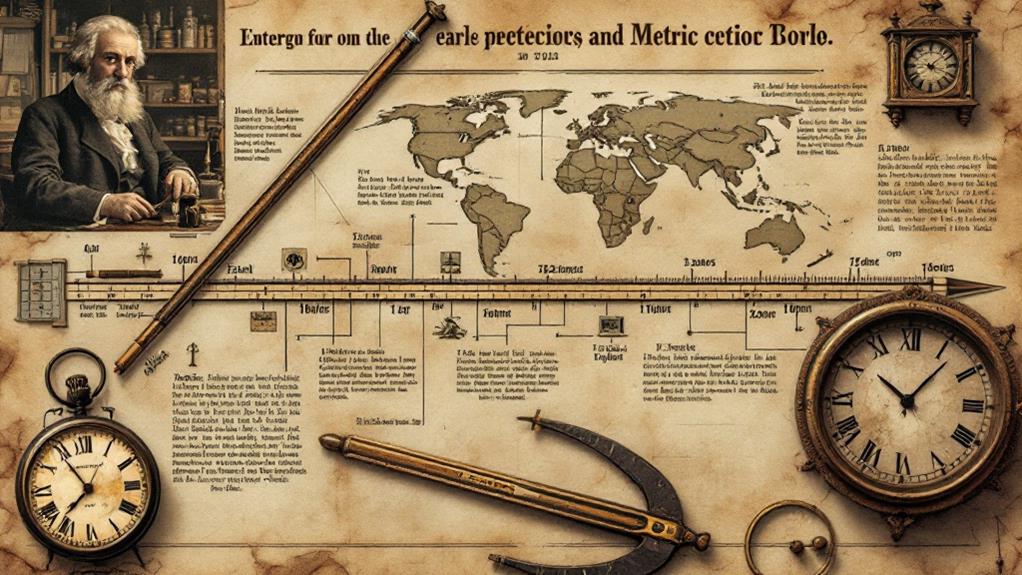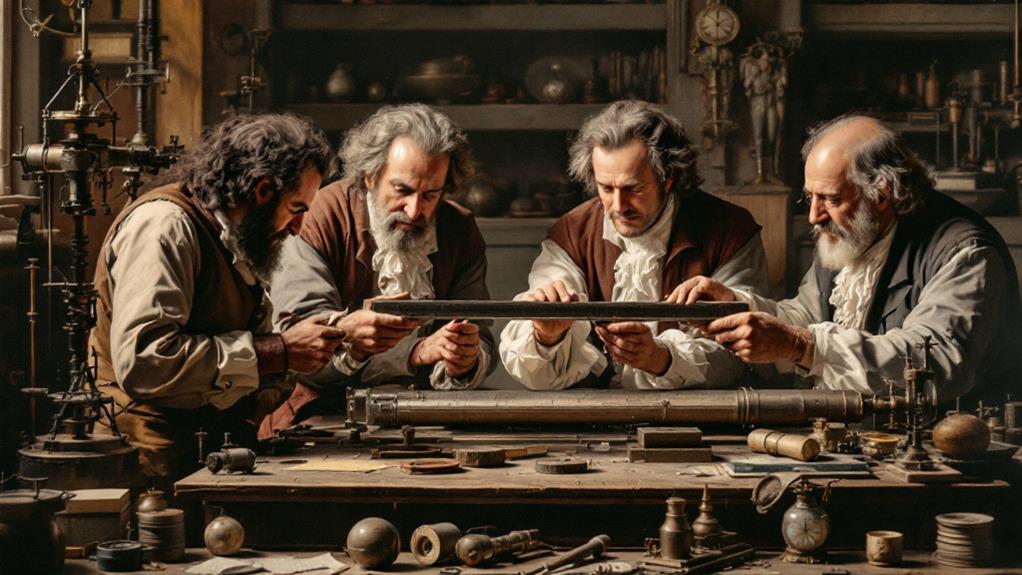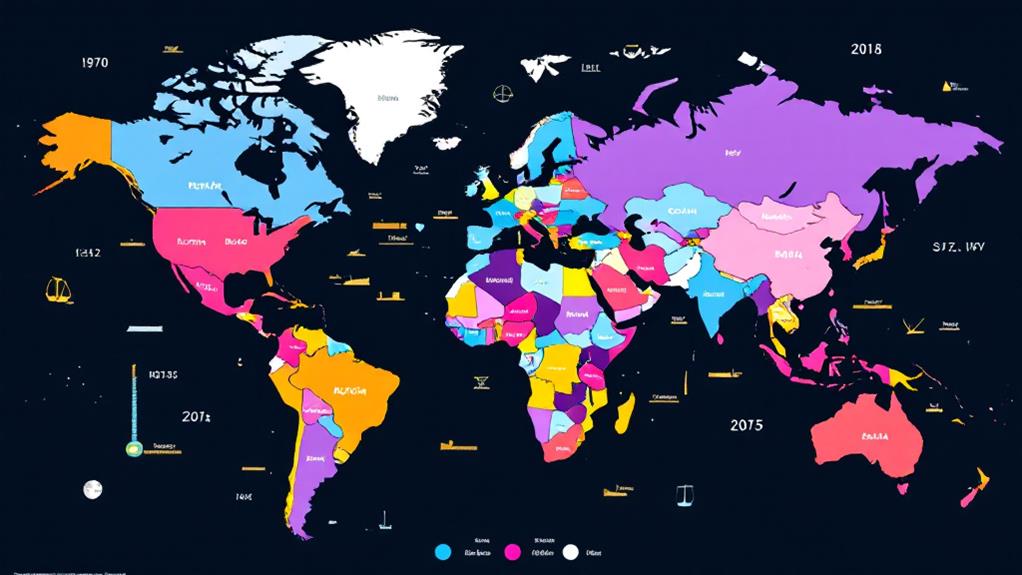How Was the Metric System Developed? The History of the World’s Measurement System

You'll ascertain that the metric system was developed during the French Revolution to unify diverse measurement standards. Before then, inconsistent systems plagued trade and science, causing errors and chaos. Pioneering figures like Gabriel Mouton and Pierre-Simon Laplace played vital roles in evolving a decimal-based system, aiming for universal standards. The metre was initially defined in 1791, and global standardization followed the Metre Convention of 1875. Despite initial resistance, the metric system's precision and simplicity have led to worldwide adoption. There's much more fascinating history behind this revolutionary transformation of measurement systems.
Origins of Measurement Systems
The origins of measurement systems date back to ancient civilizations that needed to quantify and communicate dimensions for trade, construction, and daily life. You can imagine how ancient measurements varied culturally, as each region developed its own standards. For instance, the Egyptians used the cubit, based on the length of a forearm, while the Mesopotamians relied on a system involving barleycorns. These cultural variations highlight the historical significance of measurement systems in shaping societies and facilitating interactions.
In your exploration of these systems, you'll find that regional standards were essential for practical applications. They allowed communities to build structures with precision, conduct trade with fair exchanges, and manage resources efficiently. The trade implications were vast; without some form of measurement, bartering goods of equal value would have been impossible. As trade expanded, so did the need for more refined measurements, prompting a fascinating measurement evolution.
Yet, despite these advancements, achieving scientific accuracy was challenging due to inconsistencies across regions. This inconsistency laid the groundwork for a more unified approach, paving the way for future developments. Through these ancient systems, you can trace the progression towards the precise measurements we use today.
The Need for Standardization
As measurement systems evolved, the lack of consistency across regions became increasingly problematic, especially in science and international trade. You can imagine the chaos when a trader in one country used feet, while another used cubits. This inconsistency led to errors and misunderstandings, impacting commerce and scientific progress. Measurement accuracy was vital, yet difficult to achieve when everyone played by different rules.
In a historical context, the diversity of measurement systems reflected local customs and resources. However, as societies interacted more, especially through trade and scientific exchange, the drawbacks of this diversity became apparent. Imagine trying to collaborate on scientific research with colleagues worldwide, only to find that everyone's using different units. It's like trying to solve a puzzle with mismatched pieces.
You'd agree that standardization wasn't just a good idea; it was fundamental. Without it, the accuracy of measurements couldn't be guaranteed, and progress would stall. The need for a unified system became evident, driving nations to seek a solution. This desire for consistency set the stage for developing a system that would eventually revolutionize how the world measured and understood its environment.
France's Revolutionary Influence

Vision and determination set France on a path to revolutionize the world of measurement. During the French Revolution, the country was a crucible of change, driven by a desire for equality and unity. You can't ignore how this period catalyzed the need for a universal measurement system. The chaotic patchwork of local units and measures was an obstacle to trade and scientific advancement. The French Revolutionary leaders, aiming for rationality and fairness, saw standardization as a way to break away from old feudal systems and unite the nation.
In this climate, the Scientific Community played a crucial role. Scientists like Pierre-Simon Laplace and Jean-Baptiste Delambre were instrumental in the development of the metric system. They aimed to create a system based on natural constants that could be universally understood. By engaging mathematicians and astronomers, you could guarantee that the new system was not just a political tool but a scientific advancement. This confluence of revolutionary ideals and scientific rigor led to the adoption of the metric system in France in 1795, setting a precedent for the rest of the world. France's influence in reshaping measurement standards was undeniable and transformative.
The Role of the Enlightenment
Amidst the sweeping changes of the Enlightenment, curiosity and reason drove a profound shift in how people viewed the world. You'd find that this period sparked a culture where scientific progress and philosophical shifts flourished, challenging old ways of thinking. Thinkers like Newton and Voltaire encouraged a move towards rationality and empirical evidence, creating fertile ground for new ideas, including a standardized measurement system.
You could see the Enlightenment as a time when thinkers questioned tradition, seeking universal truths applicable to human experience. This mindset naturally extended to measurements, which were inconsistent and fragmented. Imagine living in a world where every region had its own measurements, making trade and communication cumbersome. Enlightenment ideals pushed for a system rooted in logic and consistency, aligning perfectly with the period's emphasis on reason.
Developing a Decimal System

Building on the Enlightenment's push for rationality, the development of a decimal system marked a significant change in standardizing measurements. You'll find that the motivation behind creating a decimal system was to simplify calculations and make them universally understandable. By using a base-ten system, the decimal architecture provided a coherent framework that aligned perfectly with the way we naturally understand numbers.
Imagine trying to manage trade and scientific experiments with inconsistent measurement systems. A decimal system brought numerical coherence, ensuring that measurements were no longer arbitrary or confusing. You could now rely on a system where each unit was logically connected, making conversions straightforward and eliminating the chaos of regional variations.
The simplicity of adding, subtracting, multiplying, and dividing by ten made day-to-day tasks easier. Regardless of whether you're measuring length, volume, or weight, the decimal system offered a seamless change across different scales. This innovation wasn't just about convenience; it was about creating a unified method that promoted clarity and precision. In adopting this system, societies could communicate more effectively, fostering collaboration and progress in numerous fields. Your everyday interactions with numbers became more intuitive, thanks to this crucial development in measurement history.
Key Figures in Metric Development
Recognizing the contributions of key figures in the development of the metric system is essential to understanding its evolution. You'll find that the metric system didn't just appear out of nowhere; it required the collective efforts of brilliant minds. One notable figure is Gabriel Mouton, a French priest, who initially suggested a decimal-based system in 1670. His idea laid the groundwork for what would become a global standard.
Later, during the French Revolution, mathematicians and scientists like Jean-Charles de Borda and Pierre-Simon Laplace played significant roles. They pushed for a system based on natural constants, promoting scientific collaboration across France. Their efforts led to the creation of the metric system as it is recognized today.
International agreements also played a significant role. The Metre Convention of 1875 was a landmark event, bringing together 17 nations to standardize measurements globally. This agreement established the International Bureau of Weights and Measures (BIPM), ensuring consistent and precise measurements worldwide.
The Metre and Kilogram Defined

While understanding the contributions of key figures gives insight into the creation of the metric system, grasping the definitions of its fundamental units is likewise vital. The metre and kilogram are the cornerstone units in this system, and their definitions have evolved to guarantee measurement precision. Initially, the metre was defined in 1791 as one ten-millionth of the distance from the North Pole to the Equator along a meridian through Paris. This definition aimed for a universal standard, relying on Earth's dimensions.
However, as scientific demands increased, a more precise metric definition was necessary. In 1983, the metre was redefined based on the speed of light in a vacuum, establishing it as the distance light travels in 1/299,792,458 seconds. This change assured unparalleled accuracy and universality.
Likewise, the kilogram's definition has transformed over time. Initially, it was the mass of a litre of water at its freezing point. Today, it is defined by the Planck constant, a fundamental constant of nature. Here are three key points to remember:
- Initial Definitions: Based on Earth's dimensions and water mass.
- Modern Redefinitions: Utilizing constants like the speed of light and Planck constant.
- Precision and Universality: Guarantees global consistency in measurements.
Initial Challenges and Resistance
The early adoption of the metric system faced significant challenges and resistance. You'd find that cultural resistance was a major hurdle, as people clung to familiar units like inches and pounds. Many saw these traditional measures as part of their identity, making change difficult. Practical challenges also arose, as switching to a new system required time and resources to recalibrate tools and train individuals.
Political opposition played a role too. Some leaders viewed the metric system as an imposition from foreign powers, fueling nationalist sentiments. They resisted changes that threatened established norms, prioritizing political agendas over scientific progress. Educational barriers further complicated matters; teaching a new system required revamping curricula and training educators, a formidable task in regions with limited resources.
Scientific skepticism wasn't uncommon either. Some scientists questioned the precision and applicability of the metric system to their specific fields, preferring established methods. Furthermore, regional variations in measurement preferences meant that adopting a universal system was far from straightforward. You'd see that overcoming these initial obstacles required a concerted effort from governments, educators, and scientists to pave the way for the metric system's eventual widespread acceptance.
Global Adoption and Expansion

Across nations, the metric system gradually gained traction and spread its influence worldwide. As countries recognized the benefits of a unified measurement system, global implementation became a priority. The metric system's simplicity and precision made it appealing, and over time, it found cultural acceptance even in regions with deeply rooted traditional systems.
You might wonder how this change occurred. Here are three key factors that contributed to its expansion:
- International Trade: The drive for standardization in trade made the metric system an attractive option for many countries. By adopting a common measurement system, nations could facilitate easier and more efficient trade relations.
- Scientific Advancement: The metric system's role in scientific research and technology growth cannot be overstated. Its precision and ease of conversion made it the preferred choice among scientists, leading to its wider acceptance in educational and technological fields globally.
- Government Initiatives: Many governments recognized the economic and social benefits of adopting the metric system. They implemented policies and educational programs to promote its use, easing the shift from traditional systems to metric.
The Metric System Today
You might be curious about the status of the metric system in the present world after its widespread adoption. Today, the metric system remains the most widely used system for measurement globally. Its simplicity and uniformity offer numerous metric system advantages, making it an integral part of science, industry, and everyday life. Nearly every country has accepted it, with just a few exceptions primarily using their traditional systems.
Modern metrication continues to evolve, ensuring the system remains relevant and precise. The International System of Units (SI) is the standard form of the metric system used today, consistently updated to reflect scientific advancements. These updates help maintain its accuracy and reliability in diverse fields such as technology, healthcare, and global trade.
In your daily life, you likely encounter the metric system through products like beverages measured in liters or temperatures in Celsius. Its universal adoption simplifies international communication and reduces errors in scientific research and commerce. Understanding and using the metric system empowers you to engage more effectively with the world. So, regardless of whether you're traveling abroad or working on a scientific project, the metric system's advantages are clear and ever-present.



